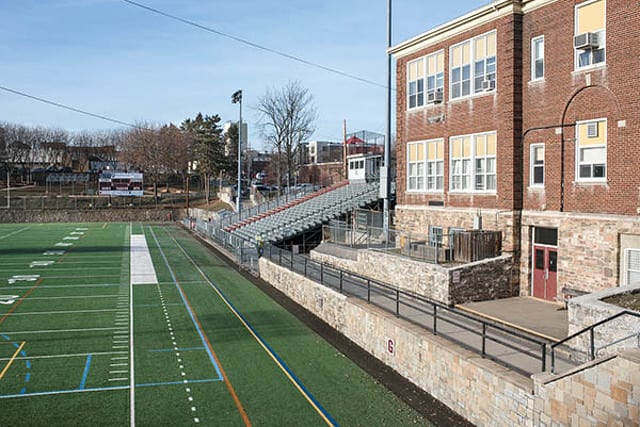As everyone knows, football is seasonal, history isn’t. But the decision on the Nittany Avenue school building wasn’t that simple.
The fate of the State College Area School District’s oldest recognized elementary school building (built in 1924 as its fifth- through eighth-grade “grammar school”) came to a vote early last month (January 9). There were two options for the building, whose last life (1965 to 2015) was as the School District Administrative Building:
• Option A: It could be gutted to become the first on-site locker room for the Little Lion football team, whose home games are at adjacent Memorial Field.
• Option B: It would be demolished, replaced by a new locker room topped by an eastern “viewing plaza” patio with spectator restrooms — the culmination of a plan centering on the attractiveness/safety and stormwater absorption of low-lying Memorial Field, which is not only the high school stadium but also downtown State College’s biggest green space and, as such, a possible place for community events.
Consistent with the school board’s 2015 assessment, the vote was for option B. On February 20, the board will hear public feedback on the selected design created by State College architectural firm Weber Murphy Fox.
A new structure integrated with new home bleachers would provide good sightlines and plaza space, nearby concessions, and the possibility of future seating expansion beyond the coming 3,429, as well as closeness of the team locker room to the field.
State College borough had nixed the offer of acquiring and relocating the old Nittany Avenue building based on cost.
In 2015, school board meetings had been moved to the former Panorama Village Elementary School, a larger building “allowing for many more” district administrative offices.
“We had just outgrown it,” says school board president Amber (Cistaro) Concepcion of the old Nittany Avenue building.
Ironically, outgrowth had necessitated its construction.
At first, the 1897 Frazier State School held all grades. In 1914, high school students got a building of their own down the street. But with population increases, the Frazier Street building (“Fraser” today) was overwhelmed. So, across from the high school, at 131 West Nittany Avenue, a grammar school was built. The brick building with symbols outlining the front door was designed by A. Lawrence Kocher, head of the Penn State architecture department. (Four years later, he was one of the advisors on Colonial Williamsburg.)
The final installation of this “central school area,” clustered not far from the heart of the downtown, was Memorial Field — once referred to as “the old sink hole” and then known as “the hollow.” Before sports, the parcel was a town dump. As school property, it changed in pursuits, becoming leveled for baseball in 1916. Memorial Field got its name in 1946; it was rededicated in 1993 to State High alumni veterans of all wars.
Today, that “central school area” is in the Holmes-Foster—Highlands Historic Neighborhood, appearing on the National Register of Historic Places. Noting “the intrinsic as well as economic benefits of historic preservation,” the Centre County Historical Society encourages “rehabilitation and adaptive reuse” for the school building, pointing to the former 1931 College Heights Elementary School. “It remains a vital part of the fabric of their neighborhood streetscape.”
Unlike the Frazier Street School, its former students can today mail letters at the succeeding US post office, but they can’t go home again. We all cling to places where we used to spend time — that can be tough for old-timers in a forward-thinking community such as State College.
• • •
In the 1950s, the eight-room Nittany Avenue School was for fifth- and sixth-graders. My early portrait of feminism was Mrs. Baney, my fifth-grade teacher, kicking a dodgeball in high-heeled red pumps during recess behind the building. (My personal athletic ability is summed up in the scar I got from tripping and falling during an impromptu tag game.)
Even after I grew up, there were a few important visits back to the old school building. It was there that I was given perspective on schooldays.
Subbing in the 1970s as a reporter covering a school board meeting, I spoke afterwards with gentlemanly John Kriner, the then principal of the then Westerly Parkway Junior High School (today’s South Building). As we chatted, I asked how he could possibly recall my first name; I hadn’t seen him since he was my eighth-grade science teacher in the former high school.
“You always remember the good students,” he replied pausing, “and the other kind.” (My attention stopped at the saber-toothed tiger.)
Truant-like, I sat in a “central office” hallway in the late 1990s, jotting down notes from antique school board minutes. Details would appear on the building’s “State College Historic Site” plaque that I had worked on. Ed Poprik, school district facilities director, was kind enough to loan an architectural drawing for the plaque.
• • •
Demolition – following a public notice – and construction will get underway in May of 2018, with completion anticipated December 2019.
In terms of a game, the decision has been a small chunk of school-district history versus progress. Fundamentals are unchanged.
Concepcion is a 1997 SCAHS graduate with a feel for history but a dedication to students and the school district’s impact on the community. Ten years ago, she and her family moved here from Washington DC, in part, because of the kids.
She says, “It was the school district here that brought us back.”



